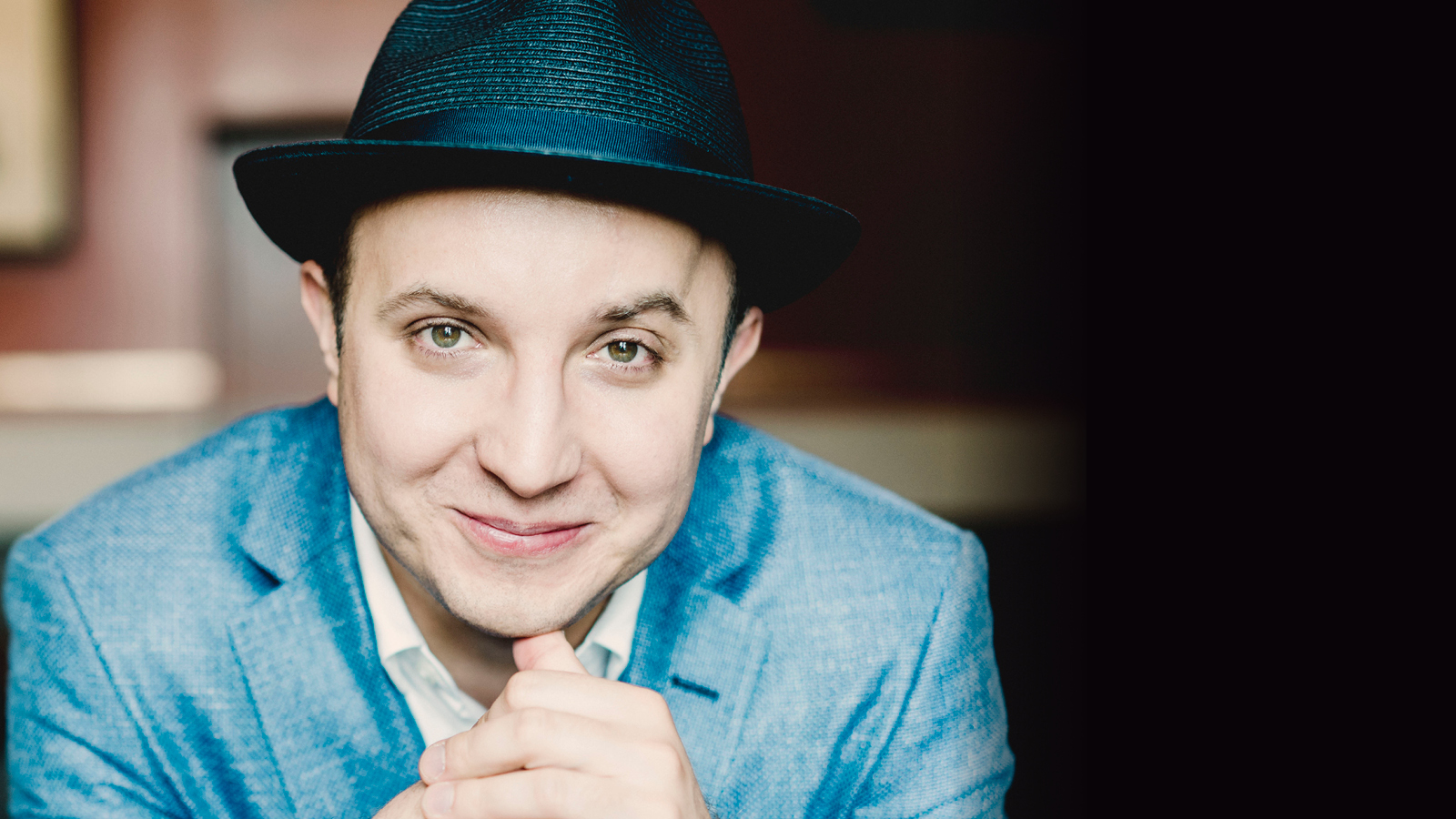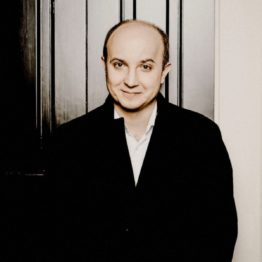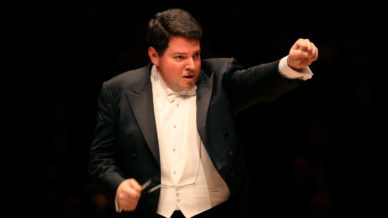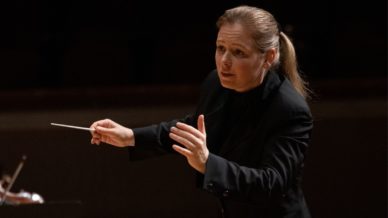

Prokofiev Concerto No. 1
May 19 – 22, 2022
GEMMA NEW conducts
ALEXANDER GAVRYLYUK piano
AARON JAY KERNIS Musica Celestis
PROKOFIEV Concerto No. 1
PROKOFIEV Romeo and Juliet: Suite
American composer and Pulitzer Prize winner Aaron Jay Kernis’s note in the score of Musica Celestis (Music of the Heavens) states that the ethereal work “is inspired by the medieval conception of that phrase, which refers to the singing of the angels in heaven in praise of God without end…”
Prokofiev’s Romeo and Juliet uses robust orchestration and complex rhythms that challenged even the best of Bolshoi dancers, yet has all the grandeur, passion and tragedy to do the Shakespearean classic justice.
Make a gift, and double the impact of your support! Thanks to a generous gift from our friends at the David M. Crowley Foundation, all new and increased gifts made by May 31, 2022 will be matched dollar-for-dollar, up to $75,000. Give Now

For information on our COVID-19 safety protocols, please visit here.
Program Notes
by René Spencer Saller
Almost immediately after completing his studies at the San Francisco Conservatory, Manhattan School of Music, and Yale University, Kernis positioned himself as a composer to watch. His 1983 composition Dream of the Morning Sky garnered copious critical buzz, along with the inevitable comparisons to Aaron Copland. In 1993 Kernis was appointed composer in residence of the St. Paul Chamber Orchestra. Five years later he won the Pulitzer Prize for his String Quartet No. 2.
Incorporating a wide-ranging array of influences—from the Baroque to the blues—Kernis marshals traditional forms in unconventional ways. He arranged Musica celestis for string orchestra, basing the composition on the second movement of his String Quartet No. 1 (1990). Musica celestis received its premiere on March 30, 1992, by the Sinfonia San Francisco, led by Ransom Wilson. Thirty years later, Musica celestis is a beloved concert opener in halls across the world.
The Composer Speaks
“Musica celestis is inspired by the medieval conception of that phrase which refers to the singing of the angels in heaven in praise of God without end. ‘The office of singing pleases God if it is performed with an attentive mind, when in this way we imitate the choirs of angels who are said to sing the Lord’s praises without ceasing.’ (Aurelian of Réöme, translated by Barbara Newman) I don’t particularly believe in angels, but found this to be a potent image that has been reinforced by listening to a good deal of medieval music, especially the soaring work of Hildegard of Bingen (1098–1179). This movement follows a simple, spacious melody and harmonic pattern through a number of variations (like a passacaglia) and modulations, and is framed by an introduction and coda.” —Aaron Jay Kernis
Prokofiev’s Romeo and Juliet—a four-act ballet turned concert suite—is every bit as singular and strange as the Shakespeare play that inspired it. Savage and sensual, tragic and comic, Prokofiev’s vivid score conveys the emotional power of its source material without sacrificing nuance and ambiguity, the rich contradictions that propel every line.
The Dancing Dead
The composition of Romeo and Juliet is almost as star-crossed a saga as that of the eponymous teenage lovers. Prokofiev got the idea to compose a ballet based on Shakespeare’s famous tragedy from Sergei Radlov, the director of the Leningrad State Academic Theater of Opera and Ballet (previously known as the Mariinsky Theater and later renamed the Kirov). Radlov helped him develop the scenario in early 1935. After the project was rejected by the Leningrad company, Prokofiev took it to the Bolshoi Theatre, in Moscow. He wrote all the music that summer, in a blur of hyperproductivity, but complications ensued. As he explained in a 1946 biographical sketch, “The Bolshoi declared it impossible to dance to.”
Even though he had already been persuaded to replace Shakespeare’s tragic ending with a happy one—”living people can dance, but the dead cannot dance lying down,” the composer drily observed—the contract was broken. Prokofiev restored the unhappy ending and rewrote the music accordingly, but the Bolshoi balked again. The ballet wasn’t performed until 1938, when the Brno Opera staged the premiere in Czechoslovakia.
Prokofiev wasn’t present. By that point, the Soviet authorities had sent his first wife to the Gulag and confiscated his passport. The unlucky functionary who commissioned Romeo and Juliet was executed, along with the one who had sanctioned Prokofiev’s original happy ending. If the composer still had any illusions about the Stalinist government that he had willingly embraced just two years earlier, when he made his prodigal-son return to the much-missed motherland, recent events must have disabused him of them.
Despite all of these obstacles and setbacks, Prokofiev, ever the pragmatist, extracted three orchestral suites and 10 piano works from his score. In January 1937 he led the Chicago Symphony in selections from the still-unstaged ballet. By the time the ballet received its Russian premiere, in 1940, the music was already a hit. Despite the dancers’ endless problems with his tricky rhythms and the usual production hassles, Romeo and Juliet was a critical and commercial success.
A Note on the Score
Rather than use one of Prokofiev’s three published orchestral suites, many conductors—including Gemma New—prefer to assemble their own versions of the suite from the 52 numbers that make up the complete ballet score. New’s selections capture the masterful pictorialism and the opulent orchestration of Prokofiev’s score while remaining true to the ballet’s emotional trajectory.
A Closer Listen
“The Montagues and the Capulets” opens with two forceful edicts from the brass and winds, representing the Duke of Verona’s authority. Right away, Prokofiev sets up the dramatic conflict between the two rival families. Against the haughty bluster of the feuding courtiers, a gentle interlude briefly represents the pensive young heroine with an exquisite duet between first and second flutes.
The characterization deepens in “The Child Juliet,” which alternates playful, skipping flights of flute-voiced fancy with a more womanly lyricism limned by the strings. “Masks,” set at the Capulets’ fateful costume ball, boasts a great deal of rhythmic variety, along with subtle shifts of mood and tone as disguised Montague partisans sneak onto enemy territory, and Romeo and Juliet transgress by falling in love.
Shakespeare’s famous “balcony scene” plays out in “Romeo and Juliet.” Against muted violins and twilit harp, Romeo, whose lines are sung by the strings, and Juliet, portrayed once again by flute, engage in flirty banter, falling harder in love with every pun, quip, and double-entendre.
“The Death of Tybalt” enacts the brutal rituals of vengeance and its aftermath. Here, in a queasy exchange of vicious percussive jabs and dissonant lurches, Romeo slays Juliet’s brother to avenge his best friend’s murder. Romeo is sentenced to exile as Tybalt’s body is solemnly borne away. Ominously thudding timpani mark the funeral procession.
In the climactic “Romeo and Juliet Before Parting,” the lovers consummate their secret marriage—discreetly suggested by a tender flute melody—and reluctantly go their separate ways. In the slow and harrowing closing number, “The Death of Juliet,” Prokofiev conveys both the anguish and the absurdity of the lovers’ shared fate. He quotes from the earlier number “The Child Juliet” as a reminder of all the lost potential, the abundant joy and love, that her suicide will squander. The music dies away as she stops breathing.




